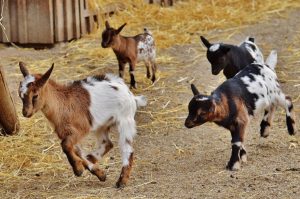Dancing Goats:Learning to enjoy coffee
by Sr. Nuala Horgan MMM Ireland 04.07.2023
 The word “coffee” comes from a place called Kaffa, which is just two hours’ drive down the road from a hospital once run by MMM in Wolisso, Ethiopia. There is a legend around there which says that the coffee bean first came to light when a young goatherd called Kaldi noticed that the goats he was herding performed an amazing ritual.
The word “coffee” comes from a place called Kaffa, which is just two hours’ drive down the road from a hospital once run by MMM in Wolisso, Ethiopia. There is a legend around there which says that the coffee bean first came to light when a young goatherd called Kaldi noticed that the goats he was herding performed an amazing ritual.
He set about investigating the origin of this strange phenomenon. He watched the goats as they grazed and noticed that they were partial to some berries hither to unnoticed. It was these berries which gave the sudden spurts of energy that caused the goats to jump and dance. Kaldi decided to experiment with the berries himself. To his great delight, he found that he, too, was energized by these magic beans.
When word reached the nearby monastery, one of the monks came to see for himself. Like Kaldi, he experimented with the berries, finding the same result. It was not long until the whole monastery was taking these berries as part of the diet. One of the most beneficial results was that the monks could stay awake for prayer during the night! For centuries, coffee was taken as a food to eat, not a drink. Berries were taken whole or crushed and mixed with ghee – butter which has been clarified. In the Ethiopian provinces of Sidamo and Kaffa, this custom is still observed.
In time, people got the idea of using coffee as an ingredient in winemaking. However, it was not until the thirteenth century that the practice of brewing coffee became the established way of taking the beverage. From then on, the love of coffee spread worldwide.
In Ethiopia, to this day, the coffee-making ceremonial is a most sacred ritual. The woman who is performing the ceremony dresses in traditional Ethiopian costume. In order to capture the atmosphere of the outside environment she spreads some freshly cut grass and sprinkles it over the floor. She seats herself on a low stool in the area of the cut grass beside a charcoal brazier, places the beans on a special concave pan to roast the beans, turning them gently.
Meanwhile, guests are given something to nibble – like small biscuits. When the beans have been sufficiently roasted, the hostess carries the pan around in front of each guest to smell the fragrance of the roasted beans. She then retires to pound them with pestle and mortar. When ready she puts water and the beans in a traditional clay coffeepot (called Jebena in Amharic). It is round and wide at the base with a special spout for pouring. She brings it to the boil and when brewed, pours this into tiny cups without handles. Sugar and rue are added. It is considered a very special treat to be invited to this ceremony, which is often performed as mark of honour for visitors.
First published by MMM in 2005
SEE ALL BLOG POSTS
